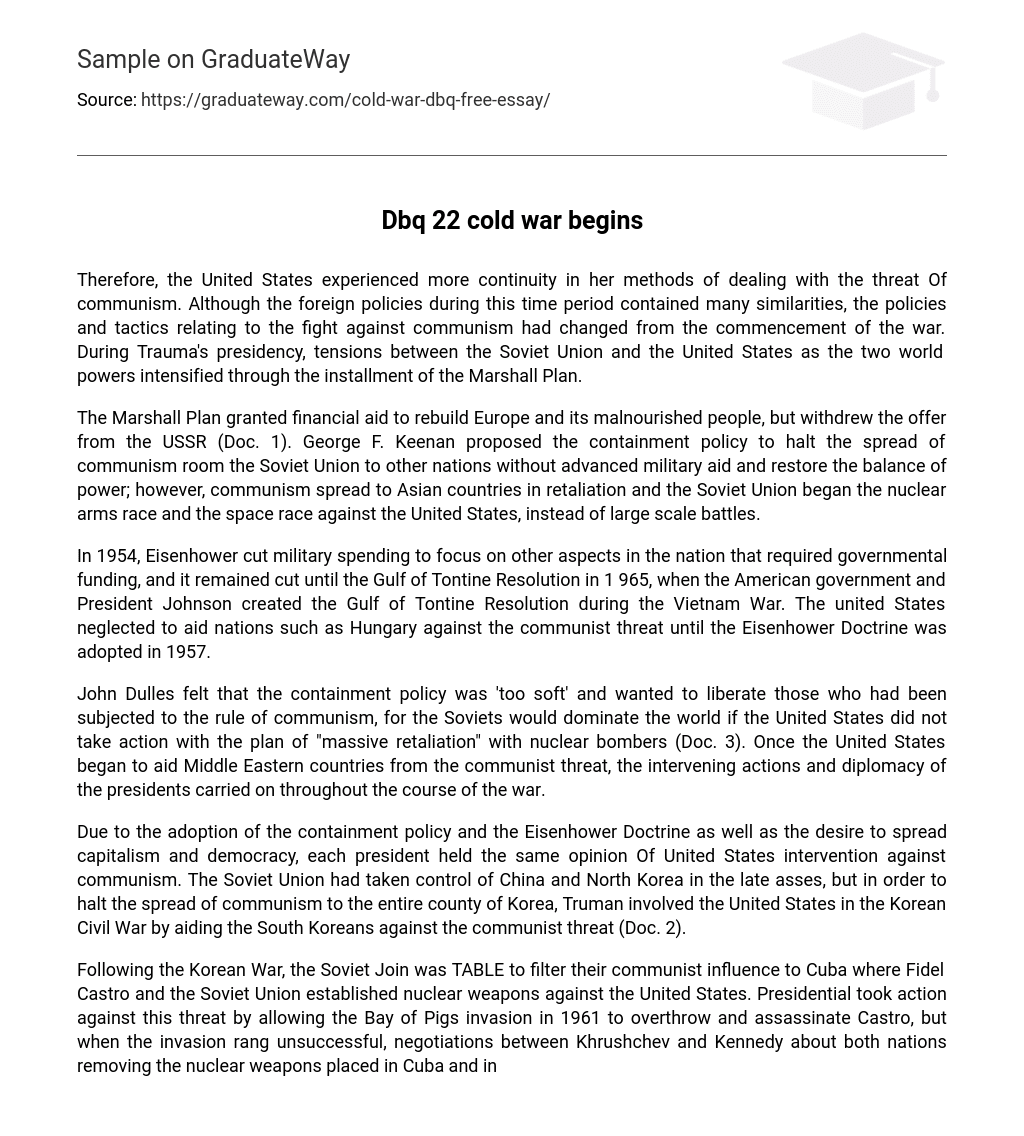Therefore, the United States experienced more continuity in her methods of dealing with the threat Of communism. Although the foreign policies during this time period contained many similarities, the policies and tactics relating to the fight against communism had changed from the commencement of the war. During Trauma’s presidency, tensions between the Soviet Union and the United States as the two world powers intensified through the installment of the Marshall Plan.
The Marshall Plan granted financial aid to rebuild Europe and its malnourished people, but withdrew the offer from the USSR (Doc. 1). George F. Keenan proposed the containment policy to halt the spread of communism room the Soviet Union to other nations without advanced military aid and restore the balance of power; however, communism spread to Asian countries in retaliation and the Soviet Union began the nuclear arms race and the space race against the United States, instead of large scale battles.
In 1954, Eisenhower cut military spending to focus on other aspects in the nation that required governmental funding, and it remained cut until the Gulf of Tontine Resolution in 1 965, when the American government and President Johnson created the Gulf of Tontine Resolution during the Vietnam War. The united States neglected to aid nations such as Hungary against the communist threat until the Eisenhower Doctrine was adopted in 1957.
John Dulles felt that the containment policy was ‘too soft’ and wanted to liberate those who had been subjected to the rule of communism, for the Soviets would dominate the world if the United States did not take action with the plan of “massive retaliation” with nuclear bombers (Doc. 3). Once the United States began to aid Middle Eastern countries from the communist threat, the intervening actions and diplomacy of the presidents carried on throughout the course of the war.
Due to the adoption of the containment policy and the Eisenhower Doctrine as well as the desire to spread capitalism and democracy, each president held the same opinion Of United States intervention against communism. The Soviet Union had taken control of China and North Korea in the late asses, but in order to halt the spread of communism to the entire county of Korea, Truman involved the United States in the Korean Civil War by aiding the South Koreans against the communist threat (Doc. 2).
Following the Korean War, the Soviet Join was TABLE to filter their communist influence to Cuba where Fidel Castro and the Soviet Union established nuclear weapons against the United States. Presidential took action against this threat by allowing the Bay of Pigs invasion in 1961 to overthrow and assassinate Castro, but when the invasion rang unsuccessful, negotiations between Khrushchev and Kennedy about both nations removing the nuclear weapons placed in Cuba and in Turkey surfaced (Doc. 4).
The Vietnam War, like the Korean War, was a Civil War pinning the communist north against the south. Eisenhower sent financial and military aid to southern Vietnam to reunify the country. JEFF increased the number of military advisors during his presidency to ensure prevention of spreading communism, but after Kennedy’s assassination, President Johnson sent in ground troops in fear of the Domino Theory (Doc. 5). President Johnson fought the communist threat in Vietnam by involving the United States against the Soviets in a ‘quagmire’ war.
The federal government had ranted Johnson a ‘blank check’ after the Gulf Of Tontine Incident, increasing military spending on air and ground troops and supplies to hinder the Vetting. However, this excessive military spending seemed fruitless as the Vetting ambushed the south with a surprise attack called the Et Offensive in 1968. Each president during the time period of the Cold War supported United States involvement against the communist threat and utilized the federal government for funding for the military both in the nation (pertaining to the Civil Rights Movement) and overseas.





